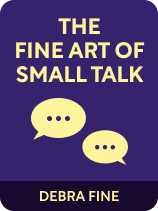

This article is an excerpt from the Shortform book guide to "The Fine Art of Small Talk" by Debra Fine. Shortform has the world's best summaries and analyses of books you should be reading.
Like this article? Sign up for a free trial here .
Do you want to know how to listen actively? What three things should you do to become a better listener?
In her book The Fine Art of Small Talk, Debra Fine explains that the three components of active listening are: 1) to give your partner visual cues, 2) give your partner verbal cues, and 3) the mental component of listening. Additionally, don’t forget that it’s not all up to the speaker to do the communicating.
Keep reading for Debra Fine’s advice on how to be a better active listener.
Active Listening Skills
Fine describes active listening as an ongoing process in which you listen fully to the speaker’s message and validate their words by giving visual and verbal feedback.
(Shortform note: To validate, in this case, means to support the speaker by showing them you understand and accept their message. In short, you’re letting them know you’ve not only heard what they’re saying, but that you’ve taken it to heart. Note that you don’t have to agree with someone’s point to validate it; just don’t ignore, reject, or judge them for sharing it.)
She also mentions a third component to active listening: engaging mentally and staying focused on the speaker.
If you want to know how to listen actively, learn these three components—you’ll make others feel heard, so they’ll actively seek you out for conversation, company, and support. Let’s look at each component in detail.
1. Give Your Partner Visual Cues
According to Fine, body language accounts for most of the social meaning of a situation. Pay attention to both yours and your partner’s: Use your body language to communicate your interest and engagement. Watch theirs to help you recognize when it’s time to change the subject or say goodbye (for instance, because their body language indicates they’re bored).
(Shortform note: Note that the signals others send with their body language aren’t always as legible as Fine implies. It’s easy to misinterpret someone else’s posture, for example, or read a signal where none is actually sent. For example, some people doodle or scribble while listening because doing so helps them focus, but you could misinterpret that behavior as a sign of their disinterest. As such, if you’re not receiving the messages or response you expect, don’t assume the connection is doomed or that one of you is doing something wrong. When in doubt, ask how the other person is feeling.)
When you converse, Fine recommends you act as if there were no distractions in the room. Face your partner openly and directly, and smile.
(Shortform note: Fine’s recommendation here may not always be advisable: Some people don’t appreciate physical directness. They may be anxious, have different physical boundaries, or prefer a more gentle, relaxed communication style. Allow others to set their own boundaries without taking offense.)
Nod, make eye contact, and stay focused on the speaker. If you have trouble maintaining eye contact, Fine suggests you look at the space between their eyes instead of directly at them; your partner won’t be able to tell the difference.
(Shortform note: What Fine suggests regarding eye contact is generally applicable in the United States, but note that it may not be appropriate when you interact with people from different backgrounds. In some places, it’s considered aggressive to gaze constantly and directly into another’s eyes.)
Be aware of what your body language implies. Don’t cross your arms and legs, place your hands on your hips, or rest your chin in your hand. Don’t fidget or keep your head down. Fine notes that these signs are typically interpreted as implying boredom, disinterest, disagreement, or hostility.
(Shortform note: Fine is arguably being a little unfair here, since the examples she provides don’t necessarily communicate boredom or disinterest. You may actually fidget because you’re anxious, uncomfortable, or nervous. If you’re worried your fidgeting may be sending the wrong message, practice hiding those nerves. Furthermore, a therapist can help you practice body language that communicates the messages you want to send.)
2. Give Your Partner Verbal Cues
Verbal cues, Fine explains, add to the reassurance provided by visual cues. Verbally indicating that you’re present and aware encourages your partner to keep speaking.
Fine notes that you can use verbal cues to show you understand, agree, disagree, or want to hear more. For example, you can say: “Hmm, I see…” “What makes you feel that way?”
You can also use verbal cues to transition to another topic. For example, you can say: “That reminds me: I’ve heard that… What do you think about that?” or “Since you’re an engineer, I wonder if you could explain…”
(Shortform note: Like the visual cues we display through our body language, the purpose of verbal cues is to inform your partner that you’re still listening, that you’re still interested, and that you’d like them to continue speaking. In short, you’re giving encouragement and reassurance. If you have trouble seeing the value in this, imagine you’re describing your symptoms to a doctor and she just sits there, staring at you, until you finish. That would be disconcerting! Instead, you’d likely prefer if she nodded along, hummed thoughtfully, and occasionally asked elaborating questions, like, “..and how long has this been going on?”)
One helpful verbal cue is to paraphrase and repeat, the author suggests. This technique lets you clarify that you understood the other person correctly, or helps them recognize where you misunderstood what they were trying to say.
Here are some common ways to paraphrase and repeat:
- “Wait, you mean he actually said that he doesn’t care what you think?”
- “So, it’s the left outlet you want me to plug it into?”
- “Sir, I just want to be sure: You’re asking me to order seven thousand copies?”
(Shortform note: The goal of paraphrasing and repeating is not just to parrot in the way Fine describes—it’s also to ensure you understand what’s being said in the spirit in which it’s intended. You’re remembering the speaker’s points, asking about them, and clarifying your understanding because it helps you connect with the speaker. You’re giving them the comfort of knowing they’re understood.)
3. The Mental Component of Listening
Finally, remember that giving visual and verbal cues that suggest you’re listening isn’t enough: You have to actually listen, too. Listening is your job in the conversation, Fine argues, and it isn’t optional.
(Shortform note: It’s not easy to listen with your full attention, as Fine suggests. Research shows we think much faster than we speak—so when we’re just listening to someone speak, our brains have plenty of time to get distracted. If you find your mind often wanders while others are meandering through a sentence, try keeping your brain engaged by focusing on more than just the speaker’s words: Watch their body language—their face, eyes, posture, and tone of voice—can you tell how they feel about the topic? Weigh the evidence of their points; is the logic sound? Think ahead and try to guess where the speaker’s thought is going. Finally, review the highlights of the conversation so far.)
| Mastering Active Listening Fine’s suggestions for how to listen actively apply to any situation in which you want a speaker to feel heard, respected, and encouraged. In some contexts, however, a great listener can do more—she can cooperatively aid the speaker in finding or describing his point. In fact, researchers suggest that a master of active listening is like a trampoline, clarifying and supporting the ideas that speakers bounce off her. She creates a nonjudgmental space and aims to help the speaker express his thoughts fully—this attitude allows both parties to expand their worldview and learn something new. To achieve this, a master listener asks constructive questions that help lead the speaker to new insights or challenge his assumptions. She creates a two-way dialogue by making suggestions, both giving and receiving feedback. Instead of just letting her partner express what he’s thinking, she can help him to realize what he’s really trying to say. Therefore, when listening actively, ensure you’re offering a safe environment to your conversational partner: As a listener, it’s not your goal to judge his character, behavior, or values. Instead, give him space to openly express himself, and don’t argue. If he shares feelings and concerns with you, validate that; let him know his feelings are understandable, relatable, and logical. When the speaker feels safe and understood, he can stop holding back and speak openly. Furthermore, as your conversational partner shares his thoughts and ideas with you, show him how those ideas look from your own perspective. Try to come to a deeper mutual understanding of the topic by combining what each of you knows, without hijacking the conversation. |

———End of Preview———
Like what you just read? Read the rest of the world's best book summary and analysis of Debra Fine's "The Fine Art of Small Talk" at Shortform .
Here's what you'll find in our full The Fine Art of Small Talk summary :
- Why we need small talk and why we shouldn't avoid it
- How to appear confident and engaging in any context
- How to break the ice with strangers and keep the conversation going






